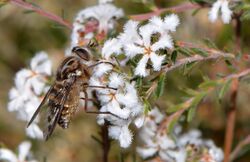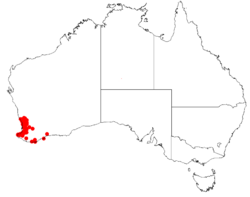Biology:Leucopogon pulchellus
| Leucopogon pulchellus | |
|---|---|

| |
| Scientific classification | |
| Kingdom: | Plantae |
| Clade: | Tracheophytes |
| Clade: | Angiosperms |
| Clade: | Eudicots |
| Clade: | Asterids |
| Order: | Ericales |
| Family: | Ericaceae |
| Genus: | Leucopogon |
| Species: | L. pulchellus
|
| Binomial name | |
| Leucopogon pulchellus Sond.[1]
| |

| |
| Occurrence data from AVH | |
| Synonyms[1] | |
|
? Leucopogon glabratus Gand. | |
Leucopogon pulchellus, commonly known as beard-heath,[2] is a species of flowering plant in the family Ericaceae, and is endemic to the south west of Western Australia. It is an erect or straggling shrub with erect, linear leaves and short, dense spikes of white, tube-shaped flowers.
Description
Leucopogon pulchellus is an erect or straggling shrub that typically grows to a height of 0.15–1 m (5.9 in–3 ft 3.4 in). Its leaves are erect, linear, mostly 4–8 mm (0.16–0.31 in) long, thick and slightly concave. The flowers are borne on the ends of branches or in upper leaf axils in short, dense spikes, with small bracts, and bracteoles less than half as long as the sepals and with a rounded tip. The sepals are about 2.6 mm (0.10 in) long, the petals white, about 4.5 mm (0.18 in) long and joined at the base, forming a short tube, the petal lobes longer than the petal tube.[2][3]
Taxonomy
Leucopogon pulchellus was first formally described in 1845 by Otto Wilhelm Sonder in Lehmann's Plantae Preissianae.[4][5] The specific epithet, (pulchellus) is derived from the Latin adjective meaning "beautiful and little".[6]
Distribution and habitat
Beard-heath mainly grows in lateritic or granitic soil in the Avon Wheatbelt, Jarrah Forest, Swan Coastal Plain and Warren bioregions of south-western Western Australia.[2]
Conservation status
Leucopogon pulchellus is listed as "not threatened" by the Western Australian Government Department of Biodiversity, Conservation and Attractions.[2]
References
- ↑ 1.0 1.1 "Leucopogon pulchellus". https://biodiversity.org.au/nsl/services/apc-format/display/67296. Retrieved 22 April 2023.
- ↑ 2.0 2.1 2.2 2.3 "Leucopogon pulchellus". FloraBase. Western Australian Government Department of Parks and Wildlife. https://florabase.dpaw.wa.gov.au/browse/profile/6439. Retrieved 31 August 2019.
- ↑ Bentham, George; von Mueller, Ferdinand (1868). Flora Australiensis. 4. London: Lovell Reeve & Co.. p. 202. https://www.biodiversitylibrary.org/page/11266425#page/211/mode/1up. Retrieved 22 April 2023.
- ↑ "Leucopogon pulchellus". APNI. https://id.biodiversity.org.au/instance/apni/475596.
- ↑ Meissner, Carl (1845). Plantae Preissianae. 1. Hamburg: Sumptibus Meissneri. p. 310. https://www.biodiversitylibrary.org/item/9227#page/315/mode/1up. Retrieved 23 April 2023.
- ↑ Stearn, W.T. (2004) "Botanical Latin" (4th ed.) p. 476, Timber Press, Oregon. ISBN:9780881926279
External links
| Wikimedia Commons has media related to Grevillea banksii. |
Leucopogon pulchellus occurrence data from Australasian Virtual Herbarium
Wikidata ☰ Q17241254 entry
 |

